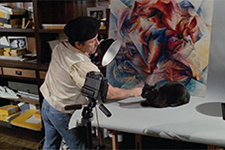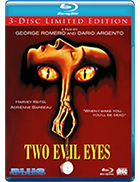Two Evil Eyes (Due occhi diabolici)
|  Almost as soon as there were movies, there were Edgar Allan Poe adaptations. The storied Gothic writer penned a litany of short stories and poems that encapsulate virtually every aspect of the modern horror genre, from shivery chills, to macabre obsessions, to outright disgust, so it is little surprise that filmmakers have been drawn to his works again and again. There were more than 20 Poe adaptations during the silent era alone, beginning with Sherlock Holmes in the Great Murder Mystery (1908), which was actually based on “The Murders in the Rue Morgue,” and D.W. Griffith’s The Avenging Conscience (1914), which drew heavily on “The Tell-Tale Heart.” In the sound era, Roger Corman’s seven 1960s Technicolor Poe adaptations, several of which starred Vincent Price, count among his most famous and accomplished films. All in all, there have been more than 300 films based on Poe’s works over the years and countless more that have drawn inspiration, ideas, and imagery from them. Thus, when Italian horror director Dario Argento began to work out an idea for an anthology film on which he would collaborate with a number of American horror directors, using Poe’s works as the binding agent made natural sense. Argento was a long-time fan of Poe’s, and elements of the author’s Gothic sensibility can be found throughout his films, particularly his early giallo like Deep Red (1975), whose co-screenwriter Bernardino Zapponi had earlier adapted Poe’s “Tony Dammit” with Federico Fellini for the Poe anthology film Spirits of the Dead (1968). Argento’s original idea was to make a four-part anthology film, with stories directed by himself, George A. Romero (Night of the Living Dead), John Carpenter (Halloween), and Wes Craven (A Nightmare on Elm Street). Unfortunately, Carpenter and Craven were not able to participate, which left only Romero and Argento to helm new adaptations of Poe’s “The Facts in the Case of Mr. Valdemar” (originally published in 1845) and “The Black Cat” (originally published in 1843). (Both “The Black Cat” and “Mr. Valdemar” had previously been adapted in Corman’s 1961 tryptich Tales of Terror, with Peter Lorre and Vincent Price as the respective stars). As each segment in the film is nearly an hour in length, Romero and Argento had to elaborate quite a bit on Poe’s stories, adding in new plot elements and characters and giving them a more modern spin. The resulting film, Two Evil Eyes (Due occhi diabolici), is a grim, uneven affair that highlights its respective directors’ strengths and weaknesses in relatively equal measure. Romero, who had recently directed the thriller Monkey Shines (1988), returns to the liminal realm of the living-dead with his adaptation of “The Facts in the Case of Mr. Valdemar,” in which a character dies while under hypnosis and is therefore caught in a nebulous world between life and death. Romero, who also wrote the screenplay, added in a subplot involving the man’s wife, Jessica (Adrienne Barbeau), being secretly involved with his doctor, Robert Hoffman (Ramy Zada). Given that Mr. Valdemar (Bingo O’Malley) is exceedingly wealthy, Jessica and Robert are scheming to collect on his riches, which ultimately necessitates their keeping his body on ice after he dies. It is at this point that they discover that, despite his body being dead, his spirit is still intact and able to communicate with them, which Jessica finds horrifying and Robert finds morbidly fascinating. Romero also works in a new wrinkle in which Valdemar’s living-dead body becomes a portal for other liminal souls to cross over into our world, resulting in the film’s most memorable bit of imagery, in which their ghostly bodies are briefly illuminated by flashes of lighting. Romero’s imagination feels somewhat limited here, and the confines of the story don’t give him space to expand beyond the obvious surface of the plot, which makes it feel more mechanical than dramatic. Argento, working with co-writer Franco Ferrini, with whom he had previously collaborated on Phenomema (1985) and Opera (1987), gives us something decidedly more sensationally gonzo in his adaptation of “The Black Cat,” which is rife with references to numerous other Poe stories, from “The Pit and the Pendulum,” to “Annabelle Lee.” Harvey Keitel, in a performance that is either singularly bad or intentionally over the top, stars as Roderick Usher (see what I mean about the additional Poe references?), an ambitious crime photographer who aspires to the rank of artiste. Usher signals his desires through his eccentric wardrobe of pretentious berets and bowties, which makes him look uniquely ridiculous while photographing a bisected corpse in a warehouse or a body in a graveyard whose mouth has been pried open and all her teeth removed. The plot is primarily domestic in nature, revolving around Usher’s increasingly strained relationship with his wife, Annabel (Madeleine Potter). Their deteriorating state of affairs is reflected in Usher’s treatment of a black cat that Annabel adopts and that takes an instant dislike to him. As part of his desperate bid to be taken seriously as an artist, Usher uses and abuses the cat to take a series of photographs that become the centerpiece of a grim book of photography he publishes, which sets off a series of events culminating in a dead body being hidden inside a wall and a pair of police detectives (led by John Amos) snooping around. Much of the film is structured around Usher’s descent into madness, as he is fueled by alcohol and repressed fear and rage that explodes in sometimes strange ways (such as an elaborate dream sequence in which he imagines himself the victim of a medieval witchhunt). “The Black Cat” is definitely a “busier” piece of work than “Mr. Valdemar.” It is almost as if Romero was determined to take his time and draw things out before getting to any visceral horror, whereas Argento is chomping at the bit to give us blood and guts and sadism. There is an anxiousness to Agento’s work here that certainly connects with his other operatic horror films, but it has a tinge of desperation to it that makes it feel unwieldy. It doesn’t help either that Keitel cuts such a kooky, unsympathetic protagonist, so that even when Argento turns on the Hitchcockian flourishes (there’s a fantastic bit involving a key falling from the top of a circular stairwell), it doesn’t entirely work. In his earlier masterpieces like Deep Red (1975) and Suspiria (1977), he was able to fuse a Gothic sensibility with a heightened, sometimes shrieking aesthetic that felt new and invigorating and bold. There are flashes of that old Argento brilliance here and there, but also too many intimations that he’s going after shock value and hysteria and little else.
Copyright © 2019 James Kendrick Thoughts? E-mail James Kendrick All images copyright © Blue Underground | |||||||||||||||||||||||||||||||
Overall Rating: 

 (2.5)
(2.5)


